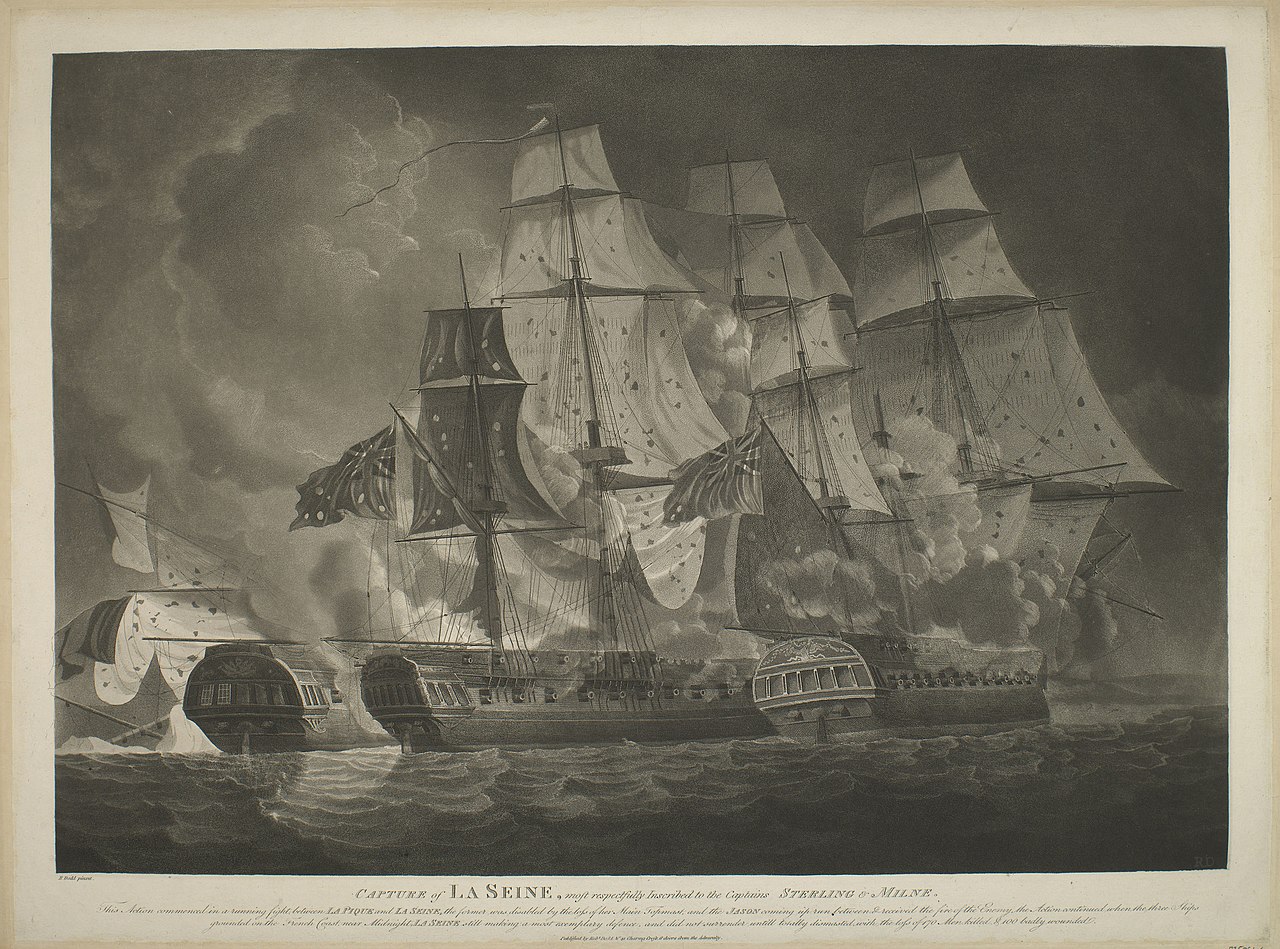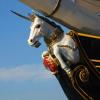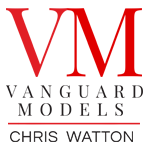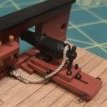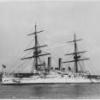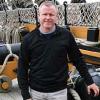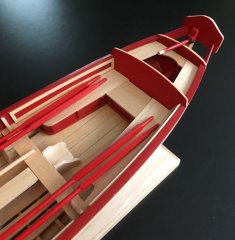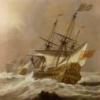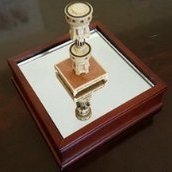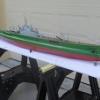-
Posts
2,245 -
Joined
-
Last visited
Reputation Activity
-
 Beef Wellington got a reaction from chris watton in HMS Jason by Beef Wellington - Caldercraft - 1:64 - Artois-class frigate modified from HMS Diana 1794
Beef Wellington got a reaction from chris watton in HMS Jason by Beef Wellington - Caldercraft - 1:64 - Artois-class frigate modified from HMS Diana 1794
Carl, Rob, Christian, Niles and the likes - thanks for your kind words, encouragement and patience on this slow voyage...
Jesse, Dave - Of course you are right, but no matter how many times I tell myself that it doesn't help...I probably have one of those personality disorders along the lines of "well he did it, so why can't I?" And yes, its gets me into trouble with those fixes around the house that I maybe shouldn't be tackling..
Anyway a little update as I really can do no more to the bow at this point, which means I need to get back to the stern...then I remembered that that was basically the reason for me taking a break and starting work on the bow...There are a couple of questions at the end.
Once the cheeks and the rails were done, I needed to tackle hawse holes and the bolsters. These had me really thinking, but first step was once again to shape from some thick stock, only this time I had to take it even slower as pretty much the entire interior face needed to fit tightly against the hull because any errors would be really obvious once the holes were cut. The balsa filler blocks were also removed (Interestingly, you can see the outline of the recess that I had put in a long while ago to try to introduce a void behind the expected hole placement to look a little more authentic...seemed a good idea at the time but they would have been in slightly the wrong place)
The holes themselves are ~6mm in diameter, and taking a drill bit of that size was clearly out of the question. The hole centers were estimated and I drilled with a 2mm bit in a hand drill. This was large enough to get a round microfile in to gradually enlarge and then use a larger round file. Once the holes were approx. 4-5mm and still quite rough, some tapered dowel was used with sandpaper around to again gradually enlarge until they were approximately the right size. All the time doing this, the bolsters were held in place with fingers so everything would align - I didn't want to commit to gluing in place just yet.
Once again, I knew I'd be making my own out of castello, but continuing the trend I think the kit supplied parts are way undersized.
One other item to take care of is the Gamming knee, the kit supplied part was generally oversized, but it was necessary to cut a new piece because the back of the knee was undersized. Not sure how much of this will be visible, but it fun to make. The hole is for the mainstay collar, some alteration will likely be needed on the head timbers but that is for another day. This is not attached yet.
And the final results...these pieces seem to really bring out the face of the ship and to my eye really add some character.
Some questions:
The bulwark are considerably thinner than they would be in scale, and although the photo makes it more obvious, this is apparent if you look for it. Also, I know that the hawse holes were lined in lead, but I'm not seeing this as a feature standing out to me looking at models, in many it seems these were just painted ochre...would welcome other's thoughts and suggestions here. I'm leaning toward a 'lead like' grey just on the inside of the bulwark but not extending over the bolster. For fellow Diana kit builders. I placed the waste rail on the starboard bow side only as it seems to me that this could cause problems with the fitment of the bow grating against the hull - anyone have any experiences on this?
-
 Beef Wellington got a reaction from BenD in HMS Jason by Beef Wellington - Caldercraft - 1:64 - Artois-class frigate modified from HMS Diana 1794
Beef Wellington got a reaction from BenD in HMS Jason by Beef Wellington - Caldercraft - 1:64 - Artois-class frigate modified from HMS Diana 1794
Carl, Rob, Christian, Niles and the likes - thanks for your kind words, encouragement and patience on this slow voyage...
Jesse, Dave - Of course you are right, but no matter how many times I tell myself that it doesn't help...I probably have one of those personality disorders along the lines of "well he did it, so why can't I?" And yes, its gets me into trouble with those fixes around the house that I maybe shouldn't be tackling..
Anyway a little update as I really can do no more to the bow at this point, which means I need to get back to the stern...then I remembered that that was basically the reason for me taking a break and starting work on the bow...There are a couple of questions at the end.
Once the cheeks and the rails were done, I needed to tackle hawse holes and the bolsters. These had me really thinking, but first step was once again to shape from some thick stock, only this time I had to take it even slower as pretty much the entire interior face needed to fit tightly against the hull because any errors would be really obvious once the holes were cut. The balsa filler blocks were also removed (Interestingly, you can see the outline of the recess that I had put in a long while ago to try to introduce a void behind the expected hole placement to look a little more authentic...seemed a good idea at the time but they would have been in slightly the wrong place)
The holes themselves are ~6mm in diameter, and taking a drill bit of that size was clearly out of the question. The hole centers were estimated and I drilled with a 2mm bit in a hand drill. This was large enough to get a round microfile in to gradually enlarge and then use a larger round file. Once the holes were approx. 4-5mm and still quite rough, some tapered dowel was used with sandpaper around to again gradually enlarge until they were approximately the right size. All the time doing this, the bolsters were held in place with fingers so everything would align - I didn't want to commit to gluing in place just yet.
Once again, I knew I'd be making my own out of castello, but continuing the trend I think the kit supplied parts are way undersized.
One other item to take care of is the Gamming knee, the kit supplied part was generally oversized, but it was necessary to cut a new piece because the back of the knee was undersized. Not sure how much of this will be visible, but it fun to make. The hole is for the mainstay collar, some alteration will likely be needed on the head timbers but that is for another day. This is not attached yet.
And the final results...these pieces seem to really bring out the face of the ship and to my eye really add some character.
Some questions:
The bulwark are considerably thinner than they would be in scale, and although the photo makes it more obvious, this is apparent if you look for it. Also, I know that the hawse holes were lined in lead, but I'm not seeing this as a feature standing out to me looking at models, in many it seems these were just painted ochre...would welcome other's thoughts and suggestions here. I'm leaning toward a 'lead like' grey just on the inside of the bulwark but not extending over the bolster. For fellow Diana kit builders. I placed the waste rail on the starboard bow side only as it seems to me that this could cause problems with the fitment of the bow grating against the hull - anyone have any experiences on this?
-
 Beef Wellington got a reaction from Jack Dusty in HMS Jason by Beef Wellington - Caldercraft - 1:64 - Artois-class frigate modified from HMS Diana 1794
Beef Wellington got a reaction from Jack Dusty in HMS Jason by Beef Wellington - Caldercraft - 1:64 - Artois-class frigate modified from HMS Diana 1794
Carl, Rob, Christian, Niles and the likes - thanks for your kind words, encouragement and patience on this slow voyage...
Jesse, Dave - Of course you are right, but no matter how many times I tell myself that it doesn't help...I probably have one of those personality disorders along the lines of "well he did it, so why can't I?" And yes, its gets me into trouble with those fixes around the house that I maybe shouldn't be tackling..
Anyway a little update as I really can do no more to the bow at this point, which means I need to get back to the stern...then I remembered that that was basically the reason for me taking a break and starting work on the bow...There are a couple of questions at the end.
Once the cheeks and the rails were done, I needed to tackle hawse holes and the bolsters. These had me really thinking, but first step was once again to shape from some thick stock, only this time I had to take it even slower as pretty much the entire interior face needed to fit tightly against the hull because any errors would be really obvious once the holes were cut. The balsa filler blocks were also removed (Interestingly, you can see the outline of the recess that I had put in a long while ago to try to introduce a void behind the expected hole placement to look a little more authentic...seemed a good idea at the time but they would have been in slightly the wrong place)
The holes themselves are ~6mm in diameter, and taking a drill bit of that size was clearly out of the question. The hole centers were estimated and I drilled with a 2mm bit in a hand drill. This was large enough to get a round microfile in to gradually enlarge and then use a larger round file. Once the holes were approx. 4-5mm and still quite rough, some tapered dowel was used with sandpaper around to again gradually enlarge until they were approximately the right size. All the time doing this, the bolsters were held in place with fingers so everything would align - I didn't want to commit to gluing in place just yet.
Once again, I knew I'd be making my own out of castello, but continuing the trend I think the kit supplied parts are way undersized.
One other item to take care of is the Gamming knee, the kit supplied part was generally oversized, but it was necessary to cut a new piece because the back of the knee was undersized. Not sure how much of this will be visible, but it fun to make. The hole is for the mainstay collar, some alteration will likely be needed on the head timbers but that is for another day. This is not attached yet.
And the final results...these pieces seem to really bring out the face of the ship and to my eye really add some character.
Some questions:
The bulwark are considerably thinner than they would be in scale, and although the photo makes it more obvious, this is apparent if you look for it. Also, I know that the hawse holes were lined in lead, but I'm not seeing this as a feature standing out to me looking at models, in many it seems these were just painted ochre...would welcome other's thoughts and suggestions here. I'm leaning toward a 'lead like' grey just on the inside of the bulwark but not extending over the bolster. For fellow Diana kit builders. I placed the waste rail on the starboard bow side only as it seems to me that this could cause problems with the fitment of the bow grating against the hull - anyone have any experiences on this?
-
 Beef Wellington got a reaction from coxswain in HMS Jason by Beef Wellington - Caldercraft - 1:64 - Artois-class frigate modified from HMS Diana 1794
Beef Wellington got a reaction from coxswain in HMS Jason by Beef Wellington - Caldercraft - 1:64 - Artois-class frigate modified from HMS Diana 1794
Carl, Rob, Christian, Niles and the likes - thanks for your kind words, encouragement and patience on this slow voyage...
Jesse, Dave - Of course you are right, but no matter how many times I tell myself that it doesn't help...I probably have one of those personality disorders along the lines of "well he did it, so why can't I?" And yes, its gets me into trouble with those fixes around the house that I maybe shouldn't be tackling..
Anyway a little update as I really can do no more to the bow at this point, which means I need to get back to the stern...then I remembered that that was basically the reason for me taking a break and starting work on the bow...There are a couple of questions at the end.
Once the cheeks and the rails were done, I needed to tackle hawse holes and the bolsters. These had me really thinking, but first step was once again to shape from some thick stock, only this time I had to take it even slower as pretty much the entire interior face needed to fit tightly against the hull because any errors would be really obvious once the holes were cut. The balsa filler blocks were also removed (Interestingly, you can see the outline of the recess that I had put in a long while ago to try to introduce a void behind the expected hole placement to look a little more authentic...seemed a good idea at the time but they would have been in slightly the wrong place)
The holes themselves are ~6mm in diameter, and taking a drill bit of that size was clearly out of the question. The hole centers were estimated and I drilled with a 2mm bit in a hand drill. This was large enough to get a round microfile in to gradually enlarge and then use a larger round file. Once the holes were approx. 4-5mm and still quite rough, some tapered dowel was used with sandpaper around to again gradually enlarge until they were approximately the right size. All the time doing this, the bolsters were held in place with fingers so everything would align - I didn't want to commit to gluing in place just yet.
Once again, I knew I'd be making my own out of castello, but continuing the trend I think the kit supplied parts are way undersized.
One other item to take care of is the Gamming knee, the kit supplied part was generally oversized, but it was necessary to cut a new piece because the back of the knee was undersized. Not sure how much of this will be visible, but it fun to make. The hole is for the mainstay collar, some alteration will likely be needed on the head timbers but that is for another day. This is not attached yet.
And the final results...these pieces seem to really bring out the face of the ship and to my eye really add some character.
Some questions:
The bulwark are considerably thinner than they would be in scale, and although the photo makes it more obvious, this is apparent if you look for it. Also, I know that the hawse holes were lined in lead, but I'm not seeing this as a feature standing out to me looking at models, in many it seems these were just painted ochre...would welcome other's thoughts and suggestions here. I'm leaning toward a 'lead like' grey just on the inside of the bulwark but not extending over the bolster. For fellow Diana kit builders. I placed the waste rail on the starboard bow side only as it seems to me that this could cause problems with the fitment of the bow grating against the hull - anyone have any experiences on this?
-
 Beef Wellington reacted to JesseLee in Syren by JesseLee - FINISHED - Model Shipways - scale: 1:64
Beef Wellington reacted to JesseLee in Syren by JesseLee - FINISHED - Model Shipways - scale: 1:64
When fitting the stern davits they didn't fit as good as they should. found that I needed to add a strip under them made them sit at the right height much better. I didn't feel the pegs beneath the kit supplied cleats were deep enough to hold well when rigging is pulling on them so I snipped them off, drilled them out and glued wire pins in that will sit deeper and grab the wood better. Stern davits and cleats on and painted.
Jesse
-
 Beef Wellington reacted to JesseLee in Syren by JesseLee - FINISHED - Model Shipways - scale: 1:64
Beef Wellington reacted to JesseLee in Syren by JesseLee - FINISHED - Model Shipways - scale: 1:64
Shaped and added timberheads. Used a strip of paper to space them out evenly.
Jesse
-
 Beef Wellington got a reaction from Kevin in HMS Jason by Beef Wellington - Caldercraft - 1:64 - Artois-class frigate modified from HMS Diana 1794
Beef Wellington got a reaction from Kevin in HMS Jason by Beef Wellington - Caldercraft - 1:64 - Artois-class frigate modified from HMS Diana 1794
Carl, Rob, Christian, Niles and the likes - thanks for your kind words, encouragement and patience on this slow voyage...
Jesse, Dave - Of course you are right, but no matter how many times I tell myself that it doesn't help...I probably have one of those personality disorders along the lines of "well he did it, so why can't I?" And yes, its gets me into trouble with those fixes around the house that I maybe shouldn't be tackling..
Anyway a little update as I really can do no more to the bow at this point, which means I need to get back to the stern...then I remembered that that was basically the reason for me taking a break and starting work on the bow...There are a couple of questions at the end.
Once the cheeks and the rails were done, I needed to tackle hawse holes and the bolsters. These had me really thinking, but first step was once again to shape from some thick stock, only this time I had to take it even slower as pretty much the entire interior face needed to fit tightly against the hull because any errors would be really obvious once the holes were cut. The balsa filler blocks were also removed (Interestingly, you can see the outline of the recess that I had put in a long while ago to try to introduce a void behind the expected hole placement to look a little more authentic...seemed a good idea at the time but they would have been in slightly the wrong place)
The holes themselves are ~6mm in diameter, and taking a drill bit of that size was clearly out of the question. The hole centers were estimated and I drilled with a 2mm bit in a hand drill. This was large enough to get a round microfile in to gradually enlarge and then use a larger round file. Once the holes were approx. 4-5mm and still quite rough, some tapered dowel was used with sandpaper around to again gradually enlarge until they were approximately the right size. All the time doing this, the bolsters were held in place with fingers so everything would align - I didn't want to commit to gluing in place just yet.
Once again, I knew I'd be making my own out of castello, but continuing the trend I think the kit supplied parts are way undersized.
One other item to take care of is the Gamming knee, the kit supplied part was generally oversized, but it was necessary to cut a new piece because the back of the knee was undersized. Not sure how much of this will be visible, but it fun to make. The hole is for the mainstay collar, some alteration will likely be needed on the head timbers but that is for another day. This is not attached yet.
And the final results...these pieces seem to really bring out the face of the ship and to my eye really add some character.
Some questions:
The bulwark are considerably thinner than they would be in scale, and although the photo makes it more obvious, this is apparent if you look for it. Also, I know that the hawse holes were lined in lead, but I'm not seeing this as a feature standing out to me looking at models, in many it seems these were just painted ochre...would welcome other's thoughts and suggestions here. I'm leaning toward a 'lead like' grey just on the inside of the bulwark but not extending over the bolster. For fellow Diana kit builders. I placed the waste rail on the starboard bow side only as it seems to me that this could cause problems with the fitment of the bow grating against the hull - anyone have any experiences on this?
-
 Beef Wellington got a reaction from Dubz in HMS Jason by Beef Wellington - Caldercraft - 1:64 - Artois-class frigate modified from HMS Diana 1794
Beef Wellington got a reaction from Dubz in HMS Jason by Beef Wellington - Caldercraft - 1:64 - Artois-class frigate modified from HMS Diana 1794
Carl, Rob, Christian, Niles and the likes - thanks for your kind words, encouragement and patience on this slow voyage...
Jesse, Dave - Of course you are right, but no matter how many times I tell myself that it doesn't help...I probably have one of those personality disorders along the lines of "well he did it, so why can't I?" And yes, its gets me into trouble with those fixes around the house that I maybe shouldn't be tackling..
Anyway a little update as I really can do no more to the bow at this point, which means I need to get back to the stern...then I remembered that that was basically the reason for me taking a break and starting work on the bow...There are a couple of questions at the end.
Once the cheeks and the rails were done, I needed to tackle hawse holes and the bolsters. These had me really thinking, but first step was once again to shape from some thick stock, only this time I had to take it even slower as pretty much the entire interior face needed to fit tightly against the hull because any errors would be really obvious once the holes were cut. The balsa filler blocks were also removed (Interestingly, you can see the outline of the recess that I had put in a long while ago to try to introduce a void behind the expected hole placement to look a little more authentic...seemed a good idea at the time but they would have been in slightly the wrong place)
The holes themselves are ~6mm in diameter, and taking a drill bit of that size was clearly out of the question. The hole centers were estimated and I drilled with a 2mm bit in a hand drill. This was large enough to get a round microfile in to gradually enlarge and then use a larger round file. Once the holes were approx. 4-5mm and still quite rough, some tapered dowel was used with sandpaper around to again gradually enlarge until they were approximately the right size. All the time doing this, the bolsters were held in place with fingers so everything would align - I didn't want to commit to gluing in place just yet.
Once again, I knew I'd be making my own out of castello, but continuing the trend I think the kit supplied parts are way undersized.
One other item to take care of is the Gamming knee, the kit supplied part was generally oversized, but it was necessary to cut a new piece because the back of the knee was undersized. Not sure how much of this will be visible, but it fun to make. The hole is for the mainstay collar, some alteration will likely be needed on the head timbers but that is for another day. This is not attached yet.
And the final results...these pieces seem to really bring out the face of the ship and to my eye really add some character.
Some questions:
The bulwark are considerably thinner than they would be in scale, and although the photo makes it more obvious, this is apparent if you look for it. Also, I know that the hawse holes were lined in lead, but I'm not seeing this as a feature standing out to me looking at models, in many it seems these were just painted ochre...would welcome other's thoughts and suggestions here. I'm leaning toward a 'lead like' grey just on the inside of the bulwark but not extending over the bolster. For fellow Diana kit builders. I placed the waste rail on the starboard bow side only as it seems to me that this could cause problems with the fitment of the bow grating against the hull - anyone have any experiences on this?
-
 Beef Wellington got a reaction from jwvolz in HMS Jason by Beef Wellington - Caldercraft - 1:64 - Artois-class frigate modified from HMS Diana 1794
Beef Wellington got a reaction from jwvolz in HMS Jason by Beef Wellington - Caldercraft - 1:64 - Artois-class frigate modified from HMS Diana 1794
Carl, Rob, Christian, Niles and the likes - thanks for your kind words, encouragement and patience on this slow voyage...
Jesse, Dave - Of course you are right, but no matter how many times I tell myself that it doesn't help...I probably have one of those personality disorders along the lines of "well he did it, so why can't I?" And yes, its gets me into trouble with those fixes around the house that I maybe shouldn't be tackling..
Anyway a little update as I really can do no more to the bow at this point, which means I need to get back to the stern...then I remembered that that was basically the reason for me taking a break and starting work on the bow...There are a couple of questions at the end.
Once the cheeks and the rails were done, I needed to tackle hawse holes and the bolsters. These had me really thinking, but first step was once again to shape from some thick stock, only this time I had to take it even slower as pretty much the entire interior face needed to fit tightly against the hull because any errors would be really obvious once the holes were cut. The balsa filler blocks were also removed (Interestingly, you can see the outline of the recess that I had put in a long while ago to try to introduce a void behind the expected hole placement to look a little more authentic...seemed a good idea at the time but they would have been in slightly the wrong place)
The holes themselves are ~6mm in diameter, and taking a drill bit of that size was clearly out of the question. The hole centers were estimated and I drilled with a 2mm bit in a hand drill. This was large enough to get a round microfile in to gradually enlarge and then use a larger round file. Once the holes were approx. 4-5mm and still quite rough, some tapered dowel was used with sandpaper around to again gradually enlarge until they were approximately the right size. All the time doing this, the bolsters were held in place with fingers so everything would align - I didn't want to commit to gluing in place just yet.
Once again, I knew I'd be making my own out of castello, but continuing the trend I think the kit supplied parts are way undersized.
One other item to take care of is the Gamming knee, the kit supplied part was generally oversized, but it was necessary to cut a new piece because the back of the knee was undersized. Not sure how much of this will be visible, but it fun to make. The hole is for the mainstay collar, some alteration will likely be needed on the head timbers but that is for another day. This is not attached yet.
And the final results...these pieces seem to really bring out the face of the ship and to my eye really add some character.
Some questions:
The bulwark are considerably thinner than they would be in scale, and although the photo makes it more obvious, this is apparent if you look for it. Also, I know that the hawse holes were lined in lead, but I'm not seeing this as a feature standing out to me looking at models, in many it seems these were just painted ochre...would welcome other's thoughts and suggestions here. I'm leaning toward a 'lead like' grey just on the inside of the bulwark but not extending over the bolster. For fellow Diana kit builders. I placed the waste rail on the starboard bow side only as it seems to me that this could cause problems with the fitment of the bow grating against the hull - anyone have any experiences on this?
-
 Beef Wellington got a reaction from Tigersteve in US Brig Syren by Gahm - Model Shipways
Beef Wellington got a reaction from Tigersteve in US Brig Syren by Gahm - Model Shipways
Hi Thomas, somehow I've missed your Syren build up to this point, wow, just wonderfully inspirational work.
-
 Beef Wellington got a reaction from Blue Ensign in HMS Jason by Beef Wellington - Caldercraft - 1:64 - Artois-class frigate modified from HMS Diana 1794
Beef Wellington got a reaction from Blue Ensign in HMS Jason by Beef Wellington - Caldercraft - 1:64 - Artois-class frigate modified from HMS Diana 1794
Carl, Rob, Christian, Niles and the likes - thanks for your kind words, encouragement and patience on this slow voyage...
Jesse, Dave - Of course you are right, but no matter how many times I tell myself that it doesn't help...I probably have one of those personality disorders along the lines of "well he did it, so why can't I?" And yes, its gets me into trouble with those fixes around the house that I maybe shouldn't be tackling..
Anyway a little update as I really can do no more to the bow at this point, which means I need to get back to the stern...then I remembered that that was basically the reason for me taking a break and starting work on the bow...There are a couple of questions at the end.
Once the cheeks and the rails were done, I needed to tackle hawse holes and the bolsters. These had me really thinking, but first step was once again to shape from some thick stock, only this time I had to take it even slower as pretty much the entire interior face needed to fit tightly against the hull because any errors would be really obvious once the holes were cut. The balsa filler blocks were also removed (Interestingly, you can see the outline of the recess that I had put in a long while ago to try to introduce a void behind the expected hole placement to look a little more authentic...seemed a good idea at the time but they would have been in slightly the wrong place)
The holes themselves are ~6mm in diameter, and taking a drill bit of that size was clearly out of the question. The hole centers were estimated and I drilled with a 2mm bit in a hand drill. This was large enough to get a round microfile in to gradually enlarge and then use a larger round file. Once the holes were approx. 4-5mm and still quite rough, some tapered dowel was used with sandpaper around to again gradually enlarge until they were approximately the right size. All the time doing this, the bolsters were held in place with fingers so everything would align - I didn't want to commit to gluing in place just yet.
Once again, I knew I'd be making my own out of castello, but continuing the trend I think the kit supplied parts are way undersized.
One other item to take care of is the Gamming knee, the kit supplied part was generally oversized, but it was necessary to cut a new piece because the back of the knee was undersized. Not sure how much of this will be visible, but it fun to make. The hole is for the mainstay collar, some alteration will likely be needed on the head timbers but that is for another day. This is not attached yet.
And the final results...these pieces seem to really bring out the face of the ship and to my eye really add some character.
Some questions:
The bulwark are considerably thinner than they would be in scale, and although the photo makes it more obvious, this is apparent if you look for it. Also, I know that the hawse holes were lined in lead, but I'm not seeing this as a feature standing out to me looking at models, in many it seems these were just painted ochre...would welcome other's thoughts and suggestions here. I'm leaning toward a 'lead like' grey just on the inside of the bulwark but not extending over the bolster. For fellow Diana kit builders. I placed the waste rail on the starboard bow side only as it seems to me that this could cause problems with the fitment of the bow grating against the hull - anyone have any experiences on this?
-
 Beef Wellington got a reaction from Timmo in HMS Jason by Beef Wellington - Caldercraft - 1:64 - Artois-class frigate modified from HMS Diana 1794
Beef Wellington got a reaction from Timmo in HMS Jason by Beef Wellington - Caldercraft - 1:64 - Artois-class frigate modified from HMS Diana 1794
Carl, Rob, Christian, Niles and the likes - thanks for your kind words, encouragement and patience on this slow voyage...
Jesse, Dave - Of course you are right, but no matter how many times I tell myself that it doesn't help...I probably have one of those personality disorders along the lines of "well he did it, so why can't I?" And yes, its gets me into trouble with those fixes around the house that I maybe shouldn't be tackling..
Anyway a little update as I really can do no more to the bow at this point, which means I need to get back to the stern...then I remembered that that was basically the reason for me taking a break and starting work on the bow...There are a couple of questions at the end.
Once the cheeks and the rails were done, I needed to tackle hawse holes and the bolsters. These had me really thinking, but first step was once again to shape from some thick stock, only this time I had to take it even slower as pretty much the entire interior face needed to fit tightly against the hull because any errors would be really obvious once the holes were cut. The balsa filler blocks were also removed (Interestingly, you can see the outline of the recess that I had put in a long while ago to try to introduce a void behind the expected hole placement to look a little more authentic...seemed a good idea at the time but they would have been in slightly the wrong place)
The holes themselves are ~6mm in diameter, and taking a drill bit of that size was clearly out of the question. The hole centers were estimated and I drilled with a 2mm bit in a hand drill. This was large enough to get a round microfile in to gradually enlarge and then use a larger round file. Once the holes were approx. 4-5mm and still quite rough, some tapered dowel was used with sandpaper around to again gradually enlarge until they were approximately the right size. All the time doing this, the bolsters were held in place with fingers so everything would align - I didn't want to commit to gluing in place just yet.
Once again, I knew I'd be making my own out of castello, but continuing the trend I think the kit supplied parts are way undersized.
One other item to take care of is the Gamming knee, the kit supplied part was generally oversized, but it was necessary to cut a new piece because the back of the knee was undersized. Not sure how much of this will be visible, but it fun to make. The hole is for the mainstay collar, some alteration will likely be needed on the head timbers but that is for another day. This is not attached yet.
And the final results...these pieces seem to really bring out the face of the ship and to my eye really add some character.
Some questions:
The bulwark are considerably thinner than they would be in scale, and although the photo makes it more obvious, this is apparent if you look for it. Also, I know that the hawse holes were lined in lead, but I'm not seeing this as a feature standing out to me looking at models, in many it seems these were just painted ochre...would welcome other's thoughts and suggestions here. I'm leaning toward a 'lead like' grey just on the inside of the bulwark but not extending over the bolster. For fellow Diana kit builders. I placed the waste rail on the starboard bow side only as it seems to me that this could cause problems with the fitment of the bow grating against the hull - anyone have any experiences on this?
-
 Beef Wellington got a reaction from Nirvana in US Brig Syren by Gahm - Model Shipways
Beef Wellington got a reaction from Nirvana in US Brig Syren by Gahm - Model Shipways
Hi Thomas, somehow I've missed your Syren build up to this point, wow, just wonderfully inspirational work.
-
 Beef Wellington reacted to Gahm in US Brig Syren by Gahm - Model Shipways
Beef Wellington reacted to Gahm in US Brig Syren by Gahm - Model Shipways
Gun rigging continued . . . 7 down and 11 to go .
I am proceeding with the gun rigging in steps of 4 guns each to keep things interesting. Starting from the stern of the model it also allows to permanently mount all the deck furniture which will no longer be impacted by the rigging of the carronades, e.g. at the current stage the steering wheel with tackles, binnacle, and capstan (image 1). Image 2 shows the rigging of the steering tackles. I chose the method where both sides are rigged and the 2 ends of the rope combined underneath the steering wheel drum (see images 2 and 3). And to answer the obvious question of how these guns could be operated in such a confined space: in case of operation the tackles for the steering wheel were unhooked and the rudder operated via the tiller without wheel. That is also the reason for the shape of the tiller which has the length and the round end typical for direct manual operation. Image 4 shows some little add-ons to my Syren serving machine. It allows seizing very small eyes but also shows the potential for other simple modifications which will come in handy when I move into the rigging phase of my model. Images 5 and 6 are some additional views of the current state of the model.
Thomas
Image 1
Image 2
Image 3
Image 4
Image 5
Image 6
-
 Beef Wellington reacted to Gahm in US Brig Syren by Gahm - Model Shipways
Beef Wellington reacted to Gahm in US Brig Syren by Gahm - Model Shipways
One of the last “deck furnitures” on my Syren model was the pump. To build it I followed Chuck’s plans enhanced by some additional details found in other descriptions of how the pump worked (Charles Davis, Mondfeld).
The major part of the pump cross bar was milled out of a brass sheet of appropriate thickness. The two end pieces consist of parts of a square brass tube, shaped according to plan and fitted on the ends of the cross bar as adapters for the handles (image 1). The platform and the stand were built out of basswood and pear (image 2). I keep using this wood combination because I want to have the advantage of pear for shaping the details, but as I initially started out with basswood I need to keep the overall appearance of the model consistent. Image 3 shows the parts which make up the pump drums. As I had decided to model the upper pump valves as well each drum is connected to a part of the pipe in which the upper valve will be moving. In image 4a the finished drums can be seen. I used a technique already described earlier in this build log (mast holes) to drill two holes in the Syren deck to receive the pipes attached to the pump (image 4b). Image 5 shows the parts and construction of the connecting arms between the pump cross bar and the upper valves. These hinged connectors are made out of brass pieces shaped according to plan and silver soldered together. In image 6 the cross bar – valve assembly can be seen before the valves are finally inserted in the pump drums. As hinge bolts I used two 0.7mm nails (Scale Hardware) per hinge, cut to correct length, one bolt inserted from each side and glued together within the middle of the hinge hole in the cross bar. That probably was the most challenging part of the whole assembly . To insure correct and consistent length of the bolts I milled the thickness of a piece of aluminum to match the bolts’ length (image 7), inserted the bolts one after the other in a predrilled hole and cut and filed down the bolts to be flush with the metal surface. Images 8 and 9 show the assembled pump.
Thomas
Image 1
Image 2
Image 3
Image 4
Image 5
Image 6
Image 7
Image 8
Image 9
-
 Beef Wellington got a reaction from mtaylor in HMS Jason by Beef Wellington - Caldercraft - 1:64 - Artois-class frigate modified from HMS Diana 1794
Beef Wellington got a reaction from mtaylor in HMS Jason by Beef Wellington - Caldercraft - 1:64 - Artois-class frigate modified from HMS Diana 1794
Carl, Rob, Christian, Niles and the likes - thanks for your kind words, encouragement and patience on this slow voyage...
Jesse, Dave - Of course you are right, but no matter how many times I tell myself that it doesn't help...I probably have one of those personality disorders along the lines of "well he did it, so why can't I?" And yes, its gets me into trouble with those fixes around the house that I maybe shouldn't be tackling..
Anyway a little update as I really can do no more to the bow at this point, which means I need to get back to the stern...then I remembered that that was basically the reason for me taking a break and starting work on the bow...There are a couple of questions at the end.
Once the cheeks and the rails were done, I needed to tackle hawse holes and the bolsters. These had me really thinking, but first step was once again to shape from some thick stock, only this time I had to take it even slower as pretty much the entire interior face needed to fit tightly against the hull because any errors would be really obvious once the holes were cut. The balsa filler blocks were also removed (Interestingly, you can see the outline of the recess that I had put in a long while ago to try to introduce a void behind the expected hole placement to look a little more authentic...seemed a good idea at the time but they would have been in slightly the wrong place)
The holes themselves are ~6mm in diameter, and taking a drill bit of that size was clearly out of the question. The hole centers were estimated and I drilled with a 2mm bit in a hand drill. This was large enough to get a round microfile in to gradually enlarge and then use a larger round file. Once the holes were approx. 4-5mm and still quite rough, some tapered dowel was used with sandpaper around to again gradually enlarge until they were approximately the right size. All the time doing this, the bolsters were held in place with fingers so everything would align - I didn't want to commit to gluing in place just yet.
Once again, I knew I'd be making my own out of castello, but continuing the trend I think the kit supplied parts are way undersized.
One other item to take care of is the Gamming knee, the kit supplied part was generally oversized, but it was necessary to cut a new piece because the back of the knee was undersized. Not sure how much of this will be visible, but it fun to make. The hole is for the mainstay collar, some alteration will likely be needed on the head timbers but that is for another day. This is not attached yet.
And the final results...these pieces seem to really bring out the face of the ship and to my eye really add some character.
Some questions:
The bulwark are considerably thinner than they would be in scale, and although the photo makes it more obvious, this is apparent if you look for it. Also, I know that the hawse holes were lined in lead, but I'm not seeing this as a feature standing out to me looking at models, in many it seems these were just painted ochre...would welcome other's thoughts and suggestions here. I'm leaning toward a 'lead like' grey just on the inside of the bulwark but not extending over the bolster. For fellow Diana kit builders. I placed the waste rail on the starboard bow side only as it seems to me that this could cause problems with the fitment of the bow grating against the hull - anyone have any experiences on this?
-
 Beef Wellington reacted to Gahm in US Brig Syren by Gahm - Model Shipways
Beef Wellington reacted to Gahm in US Brig Syren by Gahm - Model Shipways
After getting distracted by a lot of other (mostly business related) projects I finally found some time to resume work on my Syren. Now the long gun prototypes, which I have shown on my model during the last 2 years, need to be replaced with the final versions. As there are only 2 guns I decided to make the gun barrels myself based on Chuck’s Syren plans. Images 1a – 1d show the different steps of turning one of the gun barrels. In image 2e the trunnion holes are drilled. After a “sanity check” with one of the gun carriages from the Syren kit the barrel is separated from the raw metal piece and the gun muzzle finished (img 2g). Img 3a shows the barrel with trunnions in place, the locations for the breech ring and touch-hole parts milled out, and the parts lying beside the barrel. The assembled gun barrel and Chuck’s plans are depicted in images 3b and 3c. The final result after blackening can be seen in image 4.
Thomas
Image 1
Image 2
Image 3
Image 4
-
 Beef Wellington reacted to Gahm in US Brig Syren by Gahm - Model Shipways
Beef Wellington reacted to Gahm in US Brig Syren by Gahm - Model Shipways
A little update. Things as usual are moving very slowly due to lack of modeling time (what’s new ? ). I finished the first 4 carronade carriages and the first “production” carronade (image 1).
Images 2 a-d show the fabrication of the hinges for the gun barrels. For this I milled a grove into a brass strip and silver soldered a brass tube into the grove. The result is shown in image 2a. To cut hinges from this piece with always the same width I combined my Taig lathe and my rotary tool with flex shaft (in lack of a suitable table saw) to a metal cutting device (see images 2b and c). The resulting hinges are shown in image 2d.
Image 3a and b present the method I used to determine the correct location of the hinges on the carronade carriage. I placed the gun barrel-hinge assembly on the carriage in such a way that the elevation screw was located correctly on the metal fitting and marked the front end of the hinges with masking tape. As a next step I placed the hinges alone nicely centered on the carriage, with the right distance between them and the front end aligned with the masking tape (image 3a). To help with this process I covered the carriage first with further masking tape and a double-sided sticky tape on top of the masking tape. Once aligned satisfactorily I marked the 2 front ends of the hinges on the masking tape, removed every tape with the exception of the tape with the alignment marks and mounted the hinges permanently using these marks (image 3b). Finally the gun barrel was mounted, the elevation adjusted with the elevation screw, and barrel and screw glued in place. The final result is displayed in images 4 and 5. Images 6 and 7 show the first carronade in its final place on my Syren model.
Thomas
Image 1
Image 2
Image 3
Image 4
Image 5
Image 6
Image 7
-
 Beef Wellington reacted to Gahm in US Brig Syren by Gahm - Model Shipways
Beef Wellington reacted to Gahm in US Brig Syren by Gahm - Model Shipways
As I had very limited time for ship model building during the last few weeks I turned to the gratings as an easy target for fast visible results . Image 1 shows the openings which will receive the anchor cables, images 2 and 3 depict the building of one of the gratings, image 4 shows the shot racks, and in images 5 through 7 the gratings and shot racks mounted on the Syren can be seen.
-
 Beef Wellington reacted to Gahm in US Brig Syren by Gahm - Model Shipways
Beef Wellington reacted to Gahm in US Brig Syren by Gahm - Model Shipways
During the last weeks I spent some time on the figurehead.
As shown in the following images I used a block of pear wood cut to the right dimensions with a hand scroll saw (image 1a), glued a copy of the Syren figurehead from Chuck’s plans on it, cut it out roughly with the scroll saw (image 1b) and mounted it on a copy of the bow as a stand for carving (image 1c). By means of a rotary tool, different carving knifes and my sanding sticks (already used for the head rail) I refined the shape of the figurehead (image 2). The arms (and later also the head) were separated from the body as it was easier for me to focus on the body shape and the arms/ head as individual pieces. In this way the chances are also increased not to mess up the whole figure if the one or other part does not work out the first time . The obvious disadvantage of this method is, however, that the figure needs to be pieced together later without showing too many seams. This turned out to be more challenging than initially expected.
As a next step the scales for the fish tail and the fin pattern were inscribed (image 3). To make the details more visible I enhanced them with some graphite powder gained from a pencil. The excess powder was “washed away” with Golden Oak wood stain (MinWax). Then I carved arms and head as separate pieces (image 4). Getting a decent looking face at that scale is a bit tricky.
The different parts of the figure were finally assembled, correct transitions between the parts established and the seams hidden. The result is shown in images 5 – 9.
Image 1
Image 2
Image 3
Image 4
Image 5
Image 6
Image 7
Image 8
Image 9
-
 Beef Wellington got a reaction from Landlubber Mike in HMS Jason by Beef Wellington - Caldercraft - 1:64 - Artois-class frigate modified from HMS Diana 1794
Beef Wellington got a reaction from Landlubber Mike in HMS Jason by Beef Wellington - Caldercraft - 1:64 - Artois-class frigate modified from HMS Diana 1794
Carl, Rob, Christian, Niles and the likes - thanks for your kind words, encouragement and patience on this slow voyage...
Jesse, Dave - Of course you are right, but no matter how many times I tell myself that it doesn't help...I probably have one of those personality disorders along the lines of "well he did it, so why can't I?" And yes, its gets me into trouble with those fixes around the house that I maybe shouldn't be tackling..
Anyway a little update as I really can do no more to the bow at this point, which means I need to get back to the stern...then I remembered that that was basically the reason for me taking a break and starting work on the bow...There are a couple of questions at the end.
Once the cheeks and the rails were done, I needed to tackle hawse holes and the bolsters. These had me really thinking, but first step was once again to shape from some thick stock, only this time I had to take it even slower as pretty much the entire interior face needed to fit tightly against the hull because any errors would be really obvious once the holes were cut. The balsa filler blocks were also removed (Interestingly, you can see the outline of the recess that I had put in a long while ago to try to introduce a void behind the expected hole placement to look a little more authentic...seemed a good idea at the time but they would have been in slightly the wrong place)
The holes themselves are ~6mm in diameter, and taking a drill bit of that size was clearly out of the question. The hole centers were estimated and I drilled with a 2mm bit in a hand drill. This was large enough to get a round microfile in to gradually enlarge and then use a larger round file. Once the holes were approx. 4-5mm and still quite rough, some tapered dowel was used with sandpaper around to again gradually enlarge until they were approximately the right size. All the time doing this, the bolsters were held in place with fingers so everything would align - I didn't want to commit to gluing in place just yet.
Once again, I knew I'd be making my own out of castello, but continuing the trend I think the kit supplied parts are way undersized.
One other item to take care of is the Gamming knee, the kit supplied part was generally oversized, but it was necessary to cut a new piece because the back of the knee was undersized. Not sure how much of this will be visible, but it fun to make. The hole is for the mainstay collar, some alteration will likely be needed on the head timbers but that is for another day. This is not attached yet.
And the final results...these pieces seem to really bring out the face of the ship and to my eye really add some character.
Some questions:
The bulwark are considerably thinner than they would be in scale, and although the photo makes it more obvious, this is apparent if you look for it. Also, I know that the hawse holes were lined in lead, but I'm not seeing this as a feature standing out to me looking at models, in many it seems these were just painted ochre...would welcome other's thoughts and suggestions here. I'm leaning toward a 'lead like' grey just on the inside of the bulwark but not extending over the bolster. For fellow Diana kit builders. I placed the waste rail on the starboard bow side only as it seems to me that this could cause problems with the fitment of the bow grating against the hull - anyone have any experiences on this?
-
 Beef Wellington reacted to ccoyle in HMS Victory by Bishophobbies - FINISHED - Heller/Imai - Scale 1:100 - PLASTIC - As she appeared at Trafalgar
Beef Wellington reacted to ccoyle in HMS Victory by Bishophobbies - FINISHED - Heller/Imai - Scale 1:100 - PLASTIC - As she appeared at Trafalgar
It is true that there is a bit of a wood bias on this forum, but that's not by design. We encourage modeling in just about any medium, and by posting here you help diversify the content. Refusing to post because of a perception that 'no one notices' plastic models only helps to reinforce that perception.
Cheers!
-
 Beef Wellington reacted to Bishophobbies in HMS Victory by Bishophobbies - FINISHED - Heller/Imai - Scale 1:100 - PLASTIC - As she appeared at Trafalgar
Beef Wellington reacted to Bishophobbies in HMS Victory by Bishophobbies - FINISHED - Heller/Imai - Scale 1:100 - PLASTIC - As she appeared at Trafalgar
No one ever commented on my posts, so I stopped posting here. Well - in 6 months still no one has commented on my post - maybe there is a bias here against plastic models. I've been posting elsewhere where I've gotten a lot of notice. I have finished the ship (except for the gun ports and rope coils to go over the belaying pins) and here are the final pictures.
-
 Beef Wellington got a reaction from Piet in Santísima Trinidad by Sjors - OcCre - 1:90
Beef Wellington got a reaction from Piet in Santísima Trinidad by Sjors - OcCre - 1:90
I'm 'away' for a few months and I find you've started another model - the moss most certainly does not grow on you Sjors! (if the expression translates!) Looks like you're off to a great start despite the keel setback, should be beautiful when completed. How does she compare sizewise to the Aggy? - bigger ship but a smaller scale? I did not see the popcorn machine on the way in, is it gone already?
-
 Beef Wellington got a reaction from CiscoH in HMS Jason by Beef Wellington - Caldercraft - 1:64 - Artois-class frigate modified from HMS Diana 1794
Beef Wellington got a reaction from CiscoH in HMS Jason by Beef Wellington - Caldercraft - 1:64 - Artois-class frigate modified from HMS Diana 1794
Wow..Christian, Doug, Pat, Harvey, Carl, Tom, Wayne, VACorsair, Eamonn, and the likes, thanks guys for interest and the overly kind words. Narrative below will explain more, but think I've irrevocably stepped off the 'being happy with kit parts' ledge...this can only mean even slower progress...but perhaps more fun
I know I'm bouncing around a bit so apologies for that, but continuing foundational aspects which seem easier with the ship careened over on a towel.
Challenging Cheeks:
The kit supplied cheeks are hair rail are not that great. The cheeks themselves come nowhere near to fitting the hull, and I'm pretty sure the hull form is correct. The only option was to scratch my own cheeks. Aside from the fit, they are also seem rather undersized.
The next consideration was the hair rail and lower cheek, and decided to go whole hog and redo these as well. Given that there needs to be two of everything, I cheated and sparingly glued with PVA glue some 3mm sheet together and then cut to shape. The pieces were then separated using rubbing alcohol, and voila, 2 matching parts with the work of 1! These parts are still very slighty oversized to allow them to be fine tuned once other parts are made - necessary given I don't have any true plans to work from and that these pieces form quite a complex shape.
Photos below show hair rail prior to separation. The difference in dimensions is quite evident to that appearing in AOTS which I used as a guide for the scratch piece.
As a side note, the quality of the walnut parts are just not good, the main/false rail would need a lot a work to get presentable so suspect these will also be remade at some point.
The cheeks themselves took a long time (days) to get right due to the angled concave curve and lack of plans. Pretty happy with the results, though the parts still need some fine tuning as the rails are a little thick still I think. I'm hoping to use a scraper to give a profile to the edges, and a quick test shows that this should work OK even for a quick test. This also commits me to what will probably be my first simple carvings on the scrolls, but that's for another day.
Side by side comparison of scratch vs kit supplied pieces..

